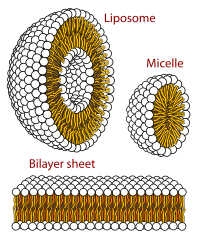Biological membrane

A biological membrane or biomembrane is an enclosing or separating amphipathic layer that acts as a barrier within or around a cell. It is, almost invariably, a lipid bilayer, composed of a double layer of lipid-class molecules, specifically phospholipids and cholesterol, with occasional proteins intertwined, some of which function as channels.[1]
Function
Such membranes typically define enclosed spaces or compartments in which cells may maintain a chemical or biochemical environment that differs from the outside. For example, the membrane around peroxisomes shields the rest of the cell from peroxides, and the plasma membrane separates a cell from its surrounding medium. Most organelles are defined by such membranes, and are called membrane-bounded organelles.
Probably the most important feature of a biomembrane is that it is a selectively-permeable structure. This means that the size, charge, and other chemical properties of the atoms and molecules attempting to cross it will determine whether they succeed to do so. Selective permeability is essential for effective separation of a cell or organelle from its surroundings. Biological membranes also have certain mechanical or elastic properties.
If a particle is too large or otherwise unable to cross the membrane by itself, but is still needed by a cell, it could either go through one of the protein channels or be taken in by means of endocytosis.
Types of biological membranes
See also
- Membrane lipids
- Endomembrane system that divides the cell into organelles
- Outer membrane or inner membrane of an organelle
- Biofilm
- Membrane protein
- Osmosis
References
- ^ Mark L. Latash (2007). Neurophysiological basis of movement. ISBN 0736063676.
External links
- Membranes at the U.S. National Library of Medicine Medical Subject Headings (MeSH)
